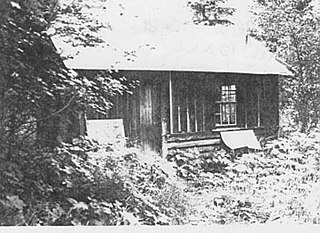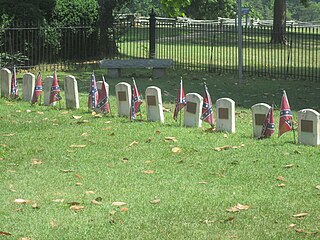
Devils Den is a boulder-strewn hill on the south end of Houck's Ridge at Gettysburg Battlefield, once used by artillery and infantry on the second day of the 1863 Battle of Gettysburg during the American Civil War. A tourist attraction since the memorial association era, several boulders are worn from foot traffic and the site includes numerous cannon, memorials, and walkways, including a bridge spanning two boulders.
The following is a list of Registered Historic Places in Allegan County, Michigan.

This is a list of the National Register of Historic Places listings in Saginaw County, Michigan.

The Brian Farm is an American Civil War area of the Gettysburg Battlefield used during the Pickett's Charge. On January 23, 2004, the farm's buildings, Boundary Stone Wall, and ID tablet were designated historic district contributing structures after the tract was used for the 1918 Camp Colt and other postbellum camps.

The Walton Ranger Station in Glacier National Park was constructed to "Standard Ranger Station, GNP" plans as a year-round station at Walton to replace the old Paola Ranger Station and to place a station near US 2, a well-traveled highway through the park. The National Park Service Rustic structure is typical of its time period.

The Sun Camp Fireguard Cabin, also known as the Baring Creek Cabin or Baring Cabin, in Glacier National Park was an example of the National Park Service Rustic style. Built in 1935 by local contractor Harry E. Doverspike, the cabin was the last remaining building of the Sun Camp Ranger Station complex of buildings, which at one time included a ranger station, barn and woodshed located near the mouth of Baring Creek. The fireguard cabin was built according to cabin specifications provided by the NPS Division of Landscape Architecture. The only apparent dissimilarity is the center-wall placement of the entry. There was no indoor plumbing and heat was provided by a wood stove whose stovepipe exited through the back log wall to a stone chimney.

The Sherburne Ranger Station in Glacier National Park is an example of the National Park Service Rustic style. Located in the Swiftcurrent portion of the park, it was built in 1926. It is part of a small historic district that includes a mess hall and subsidiary structures, formerly known as the Sherburne Road Camp, established in 1931. The ranger station closely resembles the ranger stations at Belly River and Lake McDonald. A checking station at the road remains substantially intact.

The Goathaunt Bunkhouse was built as a service structure for the Great Northern Hotel Company's development of the Goathaunt site in Glacier National Park. The bunkhouse is the last surviving structure of this era at this location, near the southern end of Waterton Lake. Its design has been attributed to National Park Service landscape architect Thomas Chalmers Vint.

The Belly River Ranger Station Historic District in Glacier National Park includes several historic structures, including the original ranger station, now used as a barn. The rustic log structures were built beginning in 1912. Other buildings include a woodshed, built in 1927 to standard National Park Service plans and a cabin used as a fire cache.

The Lower Logging Lake Snowshoe Cabin and Boathouse were built in 1933 in Glacier National Park near the southwestern end of Logging Lake. The National Park Service Rustic boathouse stores rangers' canoes for patrolling the lake and their journeys between Upper and Lower Logging Lake patrol cabins. The Lower Logging Lake snowshoe cabin is nearby. They are a significant resources both architecturally and historically, constructed for backcountry patrols.

The Buckner Homestead Historic District, near Stehekin, Washington in Lake Chelan National Recreation Area incorporates a group of structures relating to the theme of early settlement in the Lake Chelan area. Representing a time period of over six decades, from 1889 to the 1950s, the district comprises 15 buildings, landscape structures and ruins, and over 50 acres (200,000 m2) of land planted in orchard and criss-crossed by hand-dug irrigation ditches. The oldest building on the farm is a cabin built in 1889. The Buckner family bought the farm in 1910 and remained there until 1970, when the property was sold to the National Park Service. The Buckner Cabin was listed on the National Register of Historic Places in 1974. The rest of the Buckner farm became a historic district in 1989. Today, the National Park Service maintains the Buckner homestead and farm as an interpretive center to give visitors a glimpse at pioneer farm life in the Stehekin Valley.

The Mount McKinley National Park Headquarters District in what is now called Denali National Park was the original administrative center of the park. It contains an extensive collection of National Park Service Rustic structures, primarily designed by the National Park Service's Branch of Plans and Designs in the 1930s.

The Tuolumne Meadows Ranger Station and Comfort Stations are examples of National Park Service Rustic design in Yosemite National Park. They are within the Tuolumne Meadows Historic District at Tuolumne Meadows. The ranger station was built in 1924 using peeled log construction. The ranger station doubled as the park entrance station for the Tioga Road. Its function was partly superseded by a newer structure in 1936, using larger quantities of stonework.

The Appomattox Court House National Historical Park cemeteries are part of the Appomattox Court House National Historical Park, which was listed on the National Register of Historic Places on June 26, 1989.

The historical buildings and structures of Zion National Park represent a variety of buildings, interpretive structures, signs and infrastructure associated with the National Park Service's operations in Zion National Park, Utah. Structures vary in size and scale from the Zion Lodge to road culverts and curbs, nearly all of which were designed using native materials and regional construction techniques in an adapted version of the National Park Service Rustic style. A number of the larger structures were designed by Gilbert Stanley Underwood, while many of the smaller structures were designed or coordinated with the National Park Service Branch of Plans and Designs. The bulk of the historic structures date to the 1920s and 1930s. Most of the structures of the 1930s were built using Civilian Conservation Corps labor.

The Alabama State Monument, also known as the Alabama State Memorial, is an Alabama memorial in Gettysburg National Military Park that commemorates the state's Confederate units that took part in the Battle of Gettysburg. It is located in an area that was occupied by Evander M. Law's Alabama Brigade prior to their attack on the Round Tops on July 2, 1863. It was dedicated by the Alabama Division of the United Daughters of the Confederacy on November 12, 1933.
Architects of the National Park Service are the architects and landscape architects who were employed by the National Park Service (NPS) starting in 1918 to design buildings, structures, roads, trails and other features in the United States National Parks. Many of their works are listed on the National Register of Historic Places, and a number have also been designated as National Historic Landmarks.

The Toklat Ranger Station No. 4, also known as Pearson Cabin, is a log shelter in the National Park Service Rustic style in Denali National Park located near the main branch of the Toklat River at Mile 53.8, west of Park Road. It was listed on the National Register of Historic Places in 1986. It is a standard design by the National Park Service Branch of Plans and Designs and was built in 1927.

USS LCS(L)(3)-102 is an LCS(L)(3)-1 Class Landing Craft Support ship built for the United States Navy during World War II. The vessel was completed near the end of the war and saw brief service during the Battle of Okinawa. After the war, LCS(L)(3)-102 served in China before being decommissioned in 1946 and then transferred to Japan in mid-1953. Serving under the name JDS Himawari, the vessel remained in Japan until mid-1966 when she was transferred to Thailand, becoming the HTMS Nakha. In 2007, after being retired, the ship was returned to the United States to become a museum ship.

Furner Conservation Park is a protected area located in the Australian state of South Australia in the locality of Furner about 310 kilometres (190 mi) south-east of the state capital of Adelaide and about 27 kilometres (17 mi) north west of the municipal seat of Millicent.

















